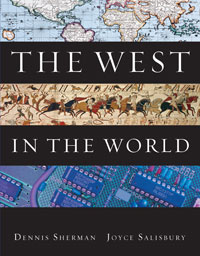 
The West in the World, 4th Edition (Sherman)Chapter 26:
Into the Twenty-First CenturyCritical Thinking Questions- The Collapse of Communism
- What were the major shortcomings of central economic planning and collectivization?
- Why were ordinary people dissatisfied with the Soviet system?
- What other developments aggravated these problems within the Soviet system?
- What were the main points of Gorbachev's reform program?
- How did the non-Russian peoples of the Soviet Union react to Gorbachev's policies?
- What developments weakened the East European Communist leaders' control over their states?
- Through what process did a non-Communist government come to power in Poland?
- How were the Communist governments in Hungary and Czechoslovakia replaced?
- How was East Germany influenced by the changes in Hungary?
- What effect did democratization and the undermining of the power of the Communist Party have in the Soviet Union?
- Which nationalities wanted independence from the Soviet Union? What was Gorbachev's solution to this problem?
- What difficulties did Eastern Europe and the former Soviet republics face in their economic transitions?
- What problems did nationalism pose in the former Soviet Union and Eastern Europe?
- How is the former Yugoslavia an extreme example of the dangers and the disruptive force of nationalism?
- Repercussions and Realignments in the West
- In what ways did the United States demonstrate its position as the last military superpower?
- How did politics shift to the Right in the West?
- Why did Western societies begin to question traditional politics?
- What steps did European states take to establish unity within the European Union?
- The World and the West From a Global Perspective
- By the 1990s, what global trends blurred national distinctions?
- In what ways did East Asia and the Pacific Rim challenge Western economic dominance?
- What types of capitalistic practices did China incorporate into its economy?
- How did Islamic states reject Western influence and ways?
- How did increased immigration change individual identities as well as cultural differences?
- What facilitated the standardization of cultural tastes?
- In what ways were artistic and intellectual movements in the 1990s "postmodern"?
- How did economic problems in one part of the world now make themselves felt immediately in another part?
- At the end of the twentieth century, what were the environmental costs of economic growth and where were they highest?
- Why did AIDS become a major epidemic?
- Why did religious revivals appear in different parts of the world at the end of the twentieth century?
- By the end of the twentieth century, what improvements and advances in individual lives and in Western society as a whole had been made?
 |  |
|





